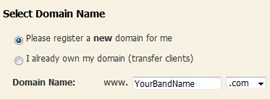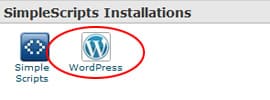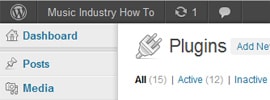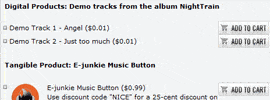How To Create Online Music Website

Music Industry How To is supported by readers. When you buy via a link on our site, we'll possibly earn an affiliate commission at no additional cost to you.
Today we're going to look at how to build a music website that will attract and keep fans. Not only will you make a super attractive website, but it'll also be fully functional and everything you could want from your band website. You can also use it to get a music download website started.
But first, if it's your aim to do music professionally, you'll want to check out our free ebook while it's still available:

Free eBook: Discover how real independent musicians like you are making $4,077 - $22,573+ monthly via Youtube, let me know where to send the details:
How To Make A Music Website In 10 Minutes
While I'll go into things in a lot more detail later, if you want to get your music site up quickly, use this quick start guide:
- Go to Justhost.
- Click 'Get Started Now'.
- Select 'Basic' (lowest) plan.
- Enter the website name you want (e.g. your band name, or music download site name) and click 'Next'.
- Enter your details & choose your Account Plan (at least a year so no one can take your website name).
- On the same page, unselect all Package Extras (you don't need them) then pay.
- In the Justhost Dashboard, Click 'Install WordPress' then carry out the instructions.
- Once done, in the Justhost Dashboard, add domain privacy (Go to Domains, then Manage, then Security. Turn on Domain Privacy).
There you go, you now have your music website up and running within 10 minutes!
From here you can add pages, change the look of your site and more. We'll show you how to do that below, but it's important you get your site up and running using the above steps before anything.
Now you've done that, here's more details on the process. 🙂
A Longer Overview Of This Guide
This guide is suitable for musicians, bands, music managers, people who want to give music business advice like myself, and anyone else who's involved in the music industry in any way that want to make a music website. In fact, even if you're not involved in the music industry, you can still follow this guide and make a cool website suitable for your industry. So feel free to share it with anyone you know that wants to make a professional website.
If you haven't already got your own website, you're missing out on one of the best tools you can use to gain new fans and keep them. Websites aren't difficult to make when you know how, and I'm about to show you how right now.
To create our website, we will be using a free content management system called WordPress. Don't download WordPress yet though, as I'll be showing you a much easier way to get it up and running on your site.
Why You Need To Create Your Own Music Website

Before we look at how to make your music website, I want to quickly explain why you'd want to do this.
I'm sure you've already got a Facebook and / or a Twitter account, so that may be enough of a web presence for your music right? Erm, no. Having your own .com website not only looks a lot more professional then just having a Facebook and Twitter account, but you can also do a lot more with your own site. You won't have the same restrictions that these external sites will have, so you can do whatever you please.
Want to put a banner on your site to increase song sales? Want to change colors to suit your brand? Want to add a form for people to sign up to your mailing list? You can do all of this and more with your own website!
Another benefit is that your site will belong to you. You won't have to worry about the site you're using becoming unpopular and having to build up your fan base from scratch again (Like what happened to many people with Myspace), your fans will always know where to find you.
There are many reasons why you should own your own site, these are two of them.
Getting Your Domain Name And Hosting Account For WordPress

Although WordPress is free to use, you will still need to buy your domain name (E.G. www.YourBandName.com) as well as web space. Web space, also known as web hosting, is the space you own online. You can use this space to store all your music, videos, pictures, and information. Without buying web space, there is no way to get your website online.
Both of these things are easy to get hold of, and can be purchased at the same time from JustHost (Disclosure: I get a commission if you sign up to JustHost using my link). This is the hosting company I use for many of my websites. I have found them to be reliable, and the cheapest around for the level of service you get.
For Music Industry How To (MIHT) specifically I used to use Justhost, but I now use WPX Hosting. This is because MIHT now gets thousands of visitors per day, and Justhost is more suited for websites which gets around 1,000 daily visits max.
While WPX has some great features (e.g. it makes your website REALLY fast, they have excellent support etc), as WPX Hosting is a lot more expensive than Justhost (like, nearly 10x the cost), you'll probably want to use Justhost when your website is still new. Then when you start getting over 1,000 or so visitors per day to your website and are making money from them, consider upgrading to WPX Hosting.
I'll continue the tutorial in this article for Justhost. If you do use WPX hosting to make your website however, the set up process is pretty similar.
Once you go on JustHost, you will need to sign up for a new account by choosing the option Need Website . On the next screen you will be able to pick your domain name, so make it a good one. Maybe your band's name?
On the same screen where is says coupon code , you will see there's a coupon already added. This will ensure you don't pay for your domain name, and that you get a reduced hosting price. Good times. 🙂
Click to continue, then on the next screen enter your details and what pricing plan you want. I suggest you don't add any of the extras they try and offer you, other then the Domain Privacy. If you don't add this, people will be able to look up who the website is registered to and see your real name and address. Not ideal for most, so ensure you get Domain Privacy.
And that's it, you now have your own website name and web space. Pretty easy to set up right? Next we need to put a website on your web space.
How To Build A Music Website With WordPress

So now we've got our website name and hosting sorted, the next thing we need to do is add a website builder to our site. By far the best free website builder on the market is WordPress, so we'll be using that.
WordPress is quick and easy to set up. It'll allow us to get a good looking website in seconds, that's highly functional and will be able to do all of what we need.
In order to install WordPress, you need to be logged into your JustHost account. In the JustHost dashboard, look for the tab called Popular Choices . Under that section you'll see a button called WordPress , so go ahead and click that. Click New Installation on the next screen, and follow the instructions on the two screens after that. And that's it, within a minute or so you'll have your new website up and running.
Make sure you save the details you add as the username and password for your WordPress install. Once done, you will be able to log into your website by adding /wp-admin to the end of you site. So for example, you'd type www.Yoursite.com/wp-admin. This will bring you to your WordPress dashboard, and allow you to edit your site.
You can now visit your website in a new window and you should see your site coming together. If it's not there yet, give it a few minutes to process and try again.
Now that you've got WordPress set up, I suggest you take a few minutes to look around and get used to the WordPress Dashboard. Everything is pretty clearly marked out, so get familiar with some of the tasks you can carry out.
If you aren't feeling particularity adventurous at this stage, no worries. We're going to walk you through the other stages of how to make a music website anyway. You do however need to be aware that the menu of the WordPress Dashboard is on the left hand site, and this will allow you to sort out all the features on your site.
Installing A Theme For A Great Looking Website

Ok, you have a basic website up and running. Now, it's time to kit it out! The first thing you'd need to do is add a theme to your site. A theme is a pre-made design that will make your site look great.
You have two options when it comes to choosing a theme for your site:
- You can get a free theme from the WordPress theme market place.
- You can buy a premium theme.
I personally always buy premium themes, and never build a music website without one. Here's why:
- They look better. Giving a good first impression is important in your music career, so having a good looking website is crucial. Free themes often don't look as good as the premium ones, as are made on a much smaller budget and by people who aren't great designers. Your fans will notice the difference.
- They can do more. Not only do these themes look a lot better then the free themes, but they are easier to use for your visitors, and you have a lot more control over how you can customize them. If you want to change the way your website is laid out, you can easily. This isn't always possible with the free themes.
- You get support. Some free themes stop working as each new WordPress update comes around. This isn't the same with Premium themes however, which have a dedicated support team ensuring their themes are compatible with each new version of WordPress. They can also offer you personal support if you need help.
With that in mind, here are some of the top simple WordPress themes for musicians around. If you want to give the best impression to your potential fans, you need to invest in a good design. And and of them in that guide will do just that.
I also like the Genesis Framework, which I have used to build Music Industry How To and many of my other sites. They have a lot of different designs to choose from, and can give a different feel no matter what type of look you want.
If you want to look at what free themes are available to you, simply go to Appearance on your WordPress Dashboard, then Themes . On the next screen you'll see a tab at the top entitled Install Themes . Click that. On the screen that comes up, you'll find the option to filter what kind of theme you want. Choose any options you may want (Or don't click any options if you want to look at all themes) then choose the Find Themes button at the end of the page.
Here you will find a selection of themes you can use. Install one and your site design will be changed instantly.
Adding Plugins To Make Your Site Do More

While WordPress is a powerful website platform by it's self, it also allows you to update the amount of things you can do with it using 'plugins'. Plugins are things you can easily install on your website and add new features. Features you can add include a comments form, social sharing buttons, media players, picture galleries, broken link checkers, and pretty much any other feature you could reasonably want from a website.
I'll recommend some plugins to get you started, but first here is how to search for them and install them.
On your WordPress Dashboard, hover over Plugins on the left hand side menu, then click on Add New . You can then search the plugin you want, and on the next screen choose Install Now on your chosen plugin (If you aren't sure of the name of a plugin, you can search for a feature you want and you can find a relevant plugin like this). If you're not sure if you want it yet, you can first click the Details button for more information on what it'll allow your site to do, and only install it when you know it's what you want. It'll ask you if you're sure you want to install the plugin, and just click OK.
On the next screen it'll tell you your plugin's installed after a few seconds, and you simply click the link to activate the plugin. And that's it, the plugin is now installed.
Some plugins require you to edit their settings to your own personal preference (Which is usually pretty easy to do), while others will work straight away without you doing anything more.
As promised, here are some cool plugins you should install to get you started and used to the process. Simply search the plugin in the way mentioned above.
- Contact Form 7.
If you want your website visitors to be able to easily contact you, you can use the Contact Form 7 plugin. This will add a contact form to any page you require, and sends you an email once the contact form is filled out. This is extremely handy, and a plugin you should definitely be using. - Share Buttons Simple Use.
Social sharing buttons are essential for any website these days. You will want your fans to share your pages and blog posts, so add these sharing buttons to them. This will make it easier for people to share, and remind them that sharing is an option. - Subscribe To Comments.
If you are going to allow people to leave comments on your website, you will want to include this plugin. What is does is allow your visitors to subscribe to the comments conversation, so they are emailed when any new comments are left on that page. This is perfect for encouraging repeat visitors to your site, and getting them involved in what you're doing. - Post Videos And Photo Galleries.
If you want to add a cool picture gallery to your website, this is the plugin to do that. It will display thumbnails of your pictures, which grows in size as your visitors click to view them. Pretty neat. - Akismet.
This is the first of two plugins I recommend for keeping your site safe and secure. What Akismet does is stop spam comments appearing on your website. While WordPress makes it so you have to approve comments before they are added, it gets annoying getting emails about new comments to approve then realizing they're spam. Akismet stops this from happening, and automatically blocks comments from known spammers. An essential plugin. - Login Lockdown.
This is the second of two plugins I recommend for keeping your site safe and secure. What Login Lockdown does is make it so that if a hacker tries to log into your site, they will be stopped. Hackers are known to try and log into other people's sites using software that tries thousands of password combinations until it gets the right one. This plugin will stop that and make your site a lot more secure.
There are a lot more plugins you can use as well, and if you want your website to have a specific function, most likely there's a plugin for that. Have a search of the plugin marketplace in your WordPress Dashboard to see some of the options.
Creating Important Pages

Now your website is looking nice and functioning well through the use of WordPress plugins, the next thing we need to do is fill it out with pages. In WordPress, pages are what you'll use to create any page you want to always appear in the same place on your site. If you want to create a blog with regularly updated news and information, you can publish each blog post via the post section. The latest blog post will always appear at the top of the page, and other blog posts get pushed down as new ones come along.
For now though, let's look at what pages you should make.
While there are a number of pages you can make depending on what you want to achieve with your site, there are a few basic pages that all website should have. These are listed below.
- Home.
Your home page is the first page people will come to if they type in www.Yourwebsite.com. Because of this, it's important that you make this page very useful, and provide links to other important areas of your site. Usually your home page will either have your latest blog posts (If you want to have a blog on your site that is), or like I said, a page with links back to important pages. You may want to have one of your videos there, as well as a link back to a page with more of your videos. Or how about a link to your shop page and about page?
You can do this however you want. Be sure to just give them a few main options however, rather than giving them every link to all your pages at once. - About.
If you want people to really connect with you and your music, you have to give off a certain image. Using your About page, you can tell them what you're about and have them feel like they know you that bit better. If someone knows about you and they take to you, it'll be a lot easier to turn that person into a life long fan. - Shop.
If you have music to sell (Which you hopefully should) you will need to include a shop page. On this shop page you can either include links to where people can buy your music on iTunes / Amazon MP3 etc, or you can sell your own digital downloads directly from your site. I'll show you how to do both in the 'Selling Your Music On Your Site' section below. - Songs And Videos.
If you haven't got many songs or videos, you may want to merge these two pages together so your website looks more full. If you have a lot of both however and want to make things a bit more clear, you may want to make these two pages separate.
As the name suggests, one of these pages will have your songs for people to hear, and the other will have your videos. I wouldn't suggest you give away too many of your songs on this page; Instead give away a few samples then direct them to your shop page or mailing list to get more. We talk a lot more about this strategy in the IMA Music Business Academy. - Gallery.
If you have any pictures you want to share with fans, this is the page to put them on. You can add a neat looking picture gallery using the 'Post Videos And Photo Galleries' plugin I mentioned above. - Contact.
Having a contact page is pretty standard on most websites these days. You'll want one of these so people can contact you about any bookings, and make connections with you in terms of the music business. It'll also be handy for receiving fan mail, although you may want to have an option for people to make it clear what they're contacting you for on this form. This will make it easier for you to filter mail based on what the person is contacting you for.
Like I said there are many other pages you could also add, so don't be afraid to think outside the box and add any others you feel are necessary. Here are a list of some others you may want to create. I've also written a guide on what kind of content musicians can create.
Selling Your Music On Your Site

If you want to sell music on your website, this is a very important stage. I suggest you give fans a choice of where they buy your music, so they can do what is best for them. You can make it so they can buy your digital downloads directly from your website, and you can make it so they have the option to buy your music from a well known music store such as iTunes.
If you want them to buy your music from iTunes or other big digital download websites, you can use the online distributor Songcast to do just that. They can upload your music to iTunes, Amazon MP3, Spotify, Napster and more. You can then link to these sites, where your songs are, from your site and sell your music that way.
A better way however, could be to sell your music directly from your own website. You can achieve this using a tool called E-Junkie. E-Junkie allows you to protect your digital downloads, and sell them automatically on your website. It allows you to create a 'buy now' button, add it to your website, and let people buy off you directly.
The good thing about E-Junkie is it doesn't require you to be there for you to make sales. Let's say for example someone comes to your site and orders your song. Even if you're not around, E-Junkie will automatically take the payment, verify it, and send your customer the song via a secure link. You will then receive the money in your PayPal account, or any other payment processor you're using.
Just to make it clear, when I said 'secure link', what I mean is it can't be shared. You can limit the amount of times your purchaser can download from the link (Say allow them to only download from the link 3 times, the number you choose is up to you), and you can also block the link from being downloaded anymore if it's being downloaded on different computers.
The download link is also made unique for each customer, so the same two links will never be made. For this reason, I feel E-Junkie is one of the best options for selling your music.
You can also sell other digitally downloadable items on E-Junkie, such as exclusive wallpapers for your fans, ringtones, or anything else you think your fans could enjoy.
Adding Analytics To Track Visitors

Now your website's set up, the next thing you may want to do is set up a system to monitor the people that are visiting your site. This is a lot easier to do then it sounds, and I'll show you a free tool you can use to do this in a little bit. First though, let's look at why you'd want to keep track of who's doing what on your site.
Monitoring your website visitors is important for a few reasons. Firstly, it allows you to see where people are finding your site from. If you look at your stats and you see the majority of your fans are finding your website from a particular forum for example, you may want to step up your promotion efforts on that forum as you know it'll probably bring you even more traffic and fans.
Monitoring your stats also allows you to see how long each visitor stays on your site, what pages they do visit when they're on there, what country they're from (Great when thinking about where you can potentially do a profitable gig), what order they do things on your website, how many repeat visitors you get, and much more.
Using these stats you can better understand who your visitor is, and modify your site and promotions accordingly. You can also create a better sales funnel for your website visitors, and in turn make more sales / gain more fans.
We talk more about how to create a good sales funnel in lesson 10 of the Academy.
While there are a lot of tools to track the visitor activity on your site, I'd recommend using Google Analytics. This is a free tool from Google, and is probably the most complete free tool on the market. It can show you all of the things I mentioned above and a lot more.
To get this started, you simply sign up for a Google Analytics account on that page, create a site profile in your Analytics account, copy and paste the bit of code they give you into your website, and that's it. It'll now allow you to see everything that's going on in your website (Traffic wise) in your Google Analytics dashboard.
It'll take a while to learn all of the things Google Analytics can do, but don't worry about everything for now. Just look at the stats that are important to you, and learn the more advanced tracking features as you go along. We've not got a guide showing tips for using Google Analytics, so check that out to get started.
An Alternative Option For Building A Music Website
While there are a lot of options when it comes to website and page builders, I've always been a fan of using WordPress to make my websites. That's why this guide showed you how to set up a WordPress website like I do.
That said, I recently got the opportunity to try out Bandzoogle for the first time in years, and I was surprised at how easy it is to set up and use.
While I like the flexibility of WordPress and ability to upgrade it in any way you see fit using plugins, I know many musicians would prefer to just have a fully functional website set up quickly and easily.
If this sounds like you, then Bandzoogle is an option you may want to look into.
Pros Of Using WordPress To Make Your Music Website
- Highly customizable. Using WordPress 'plugins', many of which are free, you can add nearly any feature you want to your website.
- WordPress is an industry standard website builder, not just in the music industry.
- It's not reliant on any one point of failure. Plugins and tools are made by all different developers, so if one stops working on your website, you can simply get another.
Cons Of Using WordPress To Run Your Music Website
- WordPress is initially more difficult to set up than Bandoogle. While with practice WordPress becomes easy enough to use, if you're not into computers, you may find it tedious. If however you're used to using laptops and are regularly on your computer, you should find it fine.
- It's not an all in one solution. You need to update your website to add the features you specifically need. Which to be fair, after doing it a couple of times, isn't normally that difficult.
Pros Of Using Bandzoogle As A Musician Who Wants Their Own Website
- Bandzoogle is an all in one solution. You simply sign up to them like you would to any other website, and within a couple of minutes you've got your own core website ready to be customized.
- Gives you all the standard tools a musician will need on their website. For example music players, a picture gallery, mailing list, a way to sell your music and merchandise, and more. Note: some of these features are on their paid plan.
- Has a free plan, so you can sign up and see if it's right for you.
Cons Of Using Bandzoogle When Building A Website For Your Music
- Single point of failure. If one of the features Bandzoogle offers stops working in the way you want it to, you can't simply switch that feature out for another provider like you could with WordPress.
- Bandzoogle has less themes and features than WordPress. Because WordPress has a huge community behind it developing new themes and plugins, it will always have a lot more options on this front.
Bandzoogle Vs WordPress, Which Should You Create Your Music Website With?
This is a question only you can answer.
Check the above pros and cons and see which are most important to you.
Both are good choices, so whichever option you go with you won't regret it.
If you're going to use Bandoogle, simply go to their site and they'll walk you through the process when you sign up.
If you've decided to use WordPress, the above guide is how you actually go about building your band's site.
How To Get Website Traffic Using SEO
So how do you start getting traffic to the music site you've just built? Well while one way is through the usually means of promotion you already use (social marketing, promoting at shows etc), another top way to drive traffic is through something called 'search engine optimization'. Or SEO for short. I've written a guide showing musicians what this is and why it's needed, so check that out for ways to up your traffic.
How To Build A Music Website Conclusion
If you prefer to learn via video, the below may help. Please note though that it's spoken word only and doesn't show on screen the process. Furthermore it doesn't display the full guide with all updates.
So that's how you create a music website for your band. Pretty simple huh? I've had a lot of people follow this guide and create a neat website for their music career, so I know you can too.
New: Feel free to show me and others the site you make using this guide in the comments section below. I've seen a lot of the sites you've all made, but it'll be great to showcase them to other people as well. Who knows, you may get a fan or two coming your way. 😉
Thanks for reading this guide. I hope you take action now that you know how to make your own music website. You can learn more about how to make a music website here.
P.S. Remember though, none of what you've learned will matter if you don't know how to get your music out there and earn from it. Want to learn how to do that? Then get our free '5 Steps To Profitable Youtube Music Career' ebook emailed directly to you!
How To Create Online Music Website
Source: https://www.musicindustryhowto.com/how-to-make-a-music-website/
Posted by: ryanreephy.blogspot.com

0 Response to "How To Create Online Music Website"
Post a Comment